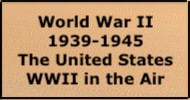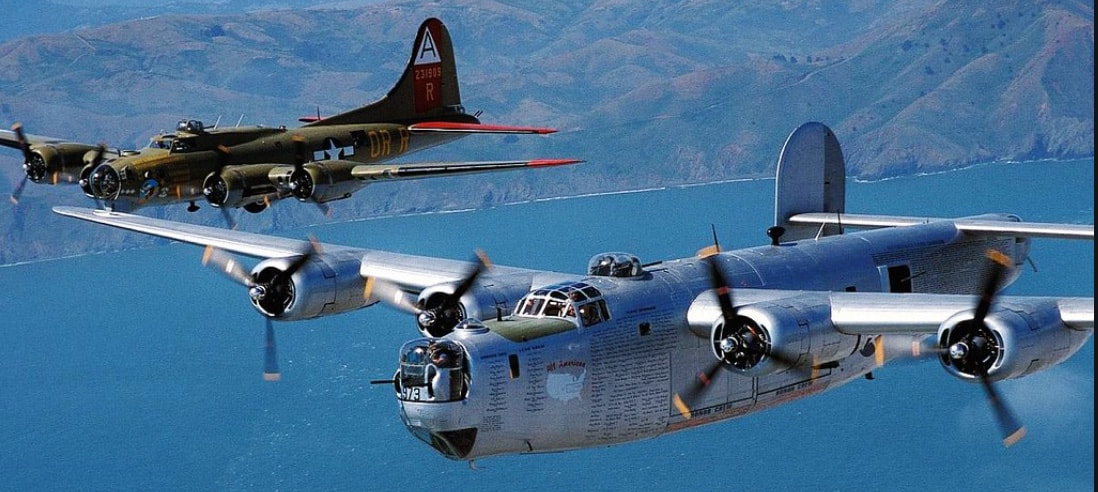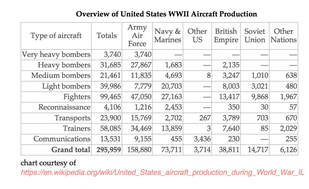bigpigeon.us webpage WWII US > WWII in the Air, © 2023 by Robert A. Christiansen, updated by RAC 30 Sep 2023.
This webpage is primarily an overview of major US aircraft and their use during WWII.
This webpage is primarily an overview of major US aircraft and their use during WWII.
Related Links:
- WWII Dead > The Land, Air, Sea Dead > the Air Dead - Pottawattamie Area WWII Dead Roster members who died in aircraft.
Part 1 - WWII In the Air - General Information
US military aviation deaths in WWII exceeded 100,000.
A company which had developed an aircraft model for the War or Navy department would often contract out aircraft assembly. Some examples of these licensing arrangements:
The US Army Air Force, US Navy Aviation, and US Marine Corps Aviation all used the same lower-level organizational structure:
Aircraft model identifiers and serial numbers:
- The USAAF suffered 52,173 deaths due to combat and 35,946 from non-combat causes. Of the 65,000 USAAF aircraft losses during WWII, a third were lost stateside during training or in other accidents, about a thousand lost in transit from the US, and the remainder lost overseas in combat or accident.
- Naval Aviation had 12,133 deaths from all causes.
- I don't have data on Marine Corps or Coast Guard aviation deaths, but Marine aviation personnel strength at the end of the war was 116,628.
A company which had developed an aircraft model for the War or Navy department would often contract out aircraft assembly. Some examples of these licensing arrangements:
- Ford assembled nearly 7,000 Consolidated Aircraft Company B-24 Liberator bombers at Ford’s Willow Run factory near Detroit.
- The Eastern Aircraft Division of General Motors assembled both Grumman Wildcats and and Grumman Avengers. Eastern assembled George H. W. Bush's Avenger, which was shot down over Chichi-Jima Island, Japan on 2 September 1944.
The US Army Air Force, US Navy Aviation, and US Marine Corps Aviation all used the same lower-level organizational structure:
- A varying number of aircraft, up to 24, formed a squadron.
- Three or four squadrons typically formed a group, with all squadrons in a group usually sharing the same base and support services.
- Sometimes a wing structure was used, with a wing consisting of one or more aircraft groups along with support services.
Aircraft model identifiers and serial numbers:
- US military aircraft models during WWII, as is the case today, had a model identifier that included the aircraft function, a model identifier, and a version code. Model identifier format varied between the Army and the Navy/Marine Corps, as shown later.
- Each aircraft purchased by the United States military in WWII had a unique serial number used to identify that individual aircraft. The serial number system also differed between the Army and the Navy.
- For certain operations, large identifiers painted on planes were also used to facilitate visual recognition.
Part 2 - Major WWII United States Army Air Force Aircraft (training aircraft appear in Part 4)
- The Army Air Force, AAF, was part of the Army, under control of the War Department, until 1947.
- At its peak, the AAF had 2,400,000 personnel and around 80,000 aircraft. During WWII, the AAF lost over 65,000 aircraft to combat and accidents.
- The AAF aircraft model identifier began with one of the type codes listed below, followed by a model number and a version code. Often this is preceded by the company holding the contract to develop that aircraft model and followed by the common name of the aircraft model. E.g., the full description of the aircraft model on which Roy Marion Pedersen died while attempting to sink the Japanese Battleship Haruna in 1945 was Consolidated B-24J Liberator.
- The AAF aircraft serial number began with two digits denoting the year in which the contract to build the plane was let, followed by a serial number for that year. A portion of the identifier generally appeared on the plane’s tail, and thus the identifier was called the tail number. E.g., the full identifier for the transport plane on which Virgil Anderson died while delivering supplies to besieged Bastogne was 42-100906 but the tail held the characters 2100906.
- Army Air Force type codes appear as a prefix:
B – Bomber (medium bombers had two engines, heavy and very heavy bombers four engines)
C – Cargo - goods or personnel transport
UC - utility cargo - small transport planes
F - Photographic (mostly used for foto-recon, i.e., photo reconnaissance)
P – Pursuit - fighter aircraft, most single engine
L – Liaison - small, slow, flimsy multi-purpose aircraft
Very Heavy Bombers: (four engine, long-range, built near end of WWII, used in strategic bombing of Japan)
- Boeing B-29 Superfortress - first flight 1942, introduced 1944, 3,970 built 1943-46.
- Consolidated B-32 Dominator - developed in case the B-29 program failed, first flight 1942, introduced 1945, only 118 built 1944-45.
- Boeing B-17 Flying Fortress - heavy bomber, first flight 1935, introduced 1938, 12,731 built 1936-45.
- Consolidated B-24 Liberator - heavy bomber, first flight 1939, introduced 1941,18,188 built 1940-45.
- Martin B-26 Marauder - medium bomber, first flight 1940, introduced 1941, 5,288 built 1941-45.
- North American B-25 Mitchell - medium bomber, first flight 1940, introduced 1941, 9,816 built.
- Douglas_A-20 Boston/Havoc -first flight 1939, introduced 1941, 7,478 built 1939-44.
- Douglas A-26 Invader - first flight 1942, 2,503 built.
- Bell P-39 Airacobra - first flight 1938, introduced 1941, 9,588 built 1940-44, heavily used by Soviet Union.
- Curtiss P-40 Warhawk - first flight 1938, introduced 1939, 17,738 built 1939-44.
- Lockheed P-38 Lightning - two engine, first flight 1939, introduced 1941, 10,037 built 1941-45.
- North American P-51 Mustang - first flight 1940, introduced 1942, over 15,000 built.
- Northrup P-61 Black Widow - radar-equipped two engine night fighter with crew of three, first flight 1942, introduced 1944, only 706 built.
- Republic P-47 Thunderbolt - first flight 1941, introduced 1942, 15,636 built 1941-45.
- Lockheed F-5 Photo Lightning - photo reconnaissance P-38 derivative, about 1,200 built.
- Consolidated C-87 Liberator Express - cargo & passenger B-24 derivative, introduced 1942, only 287 built.
- Curtiss C-46 Commando - two-engine, first flight 1940, introduced 1941, 3,181 built 1940-45.
- Douglas C-47 Skytrain/Dakota - two-engine, developed from Douglas DC-3 commercial transport, crew of four, first flight 1941, 10,174 built.
- Douglas C-54 Skymaster - four-engine, developed from Douglas DC-4 commercial transport, crew of four, first flight 1942, introduced 1942, 1,170 built.
- Cessna UC-78 (Navy JRC-1) - two engine, developed from Cessna Model T-50 light transport aircraft, 1,354 built.
- Piper L-4 Grasshopper - military version of Piper J-3 Cub, 5,611 built.
- Stinson L-5 Sentinel - crew of two, first flight 1941, 3,590 built 1942-45.
Part 3 - Major WWII United States Navy and Marine Corps Aircraft
Navy and Marine Corps aircraft notes:
N – Trainer (see Part 4)
O – Observation
OS Observation Scout
P – Patrol
PB – Patrol Bomber
SB – Scout Bomber
TB –Torpedo Bomber
PB - Patrol Bombers:
- Navy/Marine type codes appear as a prefix:
N – Trainer (see Part 4)
O – Observation
OS Observation Scout
P – Patrol
PB – Patrol Bomber
SB – Scout Bomber
TB –Torpedo Bomber
- Navy/Marine manufacturer codes appear as a suffix: A - Brewster, C – Curtis, D – Douglas, F – Grumman, M – shared by Martin and Eastern, N – Naval Aircraft Factory, S – Stearman, U – Vought, V – Lockheed Vega, Y – Consolidated.
- Starting in 1940, each plane was assigned a five or six-digit serial number called the Bureau Number, abbreviated as BuNo.
- The scout bombers, torpedo bombers, and fighters listed were all single-engine and could fly from aircraft carriers.
PB - Patrol Bombers:
- Consolidated PBY Catalina - two-engine amphibious, crew of ten, first flight 1935, introduced 1936, 3,308 built 1936-45.
- Consolidated PB2Y Coronado - four-engine amphibious, crew of ten, first flight 1937, only 217 built, primarily used as a transport.
- Consolidated PB4Y-1 Liberator & PB4Y-2 Privateer - four-engine Navy variants of B-24 Liberator, 976 & 739 built.
- Martin PBM Mariner - two-engine amphibious, crew of seven, first flight 1939, introduced 1940, 1,366 built 1940-49.
- Lockheed PV-1 Ventura/PV-2 Harpoon - two-engine, land-based, crew of six, developed from Lockheed Lodestar transport, Harpoon was a major redesign of the Ventura, first flight 1941 (Ventura), 1943 (Harpoon).
- Vought SB2U Vindicator - crew of two, first flight 1936, introduced 1937, only 260 built, last combat at Battle of Midway.
- Douglas SBD Dauntless - crew of two, first flight 1940, introduced 1940, 4,944 built 1940-1944.
- Curtiss SB2C Helldiver - crew of two, first flight 1940, introduced 1942, 7,140 built 1942-45; replaced the Douglas SBD Dauntless.
- Douglas TBD Devastator - crew of three, first flight 1935, introduced 1937, only 130 built 1937-39, last combat at the Battle of Midway.
- Grumman/Eastern TBF/TBM Avenger - crew of three, first flight 1941, introduced 1942, 9,839 built, replaced the Douglas TBD Devastator.
- Brewster F2A Buffalo - first flight 1937, introduced 1939, only 509 built 1938-41, last combat at Battle of Midway.
- Grumman F4F Wildcat - first flight 1937, introduced 1940, 7,885 built.
- Grumman F6F Hellcat - first flight 1942, introduced 1943, 12,275 built 1942-45.
- Vought F4U Corsair - first flight 1940, introduced 1942, 12,571 built 1942-53, mostly land-based during WWII.
- Vought OS2U/OS2N Kingfisher - amphibious, crew of two, launched by catapult from battleship or cruiser & retrieved by crane, first flight 1938, 1,519 built.
Part 4 - Major WWII United States Training Aircraft
The Army Air Force pilot training process:
Primary flight training - provided by 56 private contract schools contracted with the Air Force.
Basic flight training - 31 schools.
Advanced flight training - 10 schools, two tracks - future single-engine pilots and future multi-engine tracks.
Transition flight training.
The Army Air Force bombardier and navigator training process:
Advanced training of twelve weeks or longer.
Flexible gunnery training of six weeks.
Advanced training of fifteen weeks or longer.
Flexible gunnery training of six weeks.
Training Aircraft notes:
Major US WWII Training Aircraft - Primary Trainers:
- During World War II, the Army Air Force trained around 200,00 pilots and co-pilots and around 100,000 as navigators and bombardiers.
- Before a pilot was combat-ready, he would go through a five-step process:
Primary flight training - provided by 56 private contract schools contracted with the Air Force.
Basic flight training - 31 schools.
Advanced flight training - 10 schools, two tracks - future single-engine pilots and future multi-engine tracks.
Transition flight training.
- Most men in the pilot training pipeline were aviation cadets, who after completing flight training were awarded their pilot's wings and commissioned Second Lieutenants.
- Others, after completing flight training, received the rank of Flight Officer, equivalent to Staff Sergeant.
- Many did not make it through the pilot training pipeline and were reassigned to train for service in other air crew positions, such as bombardier, navigator, or gunner.
- Although pilot training times were reduced as WWII progressed, any pilot who completed the five-step program would have spent well over half a year in the pipeline.
The Army Air Force bombardier and navigator training process:
- Bombardiers:
Advanced training of twelve weeks or longer.
Flexible gunnery training of six weeks.
- Navigators:
Advanced training of fifteen weeks or longer.
Flexible gunnery training of six weeks.
Training Aircraft notes:
- The Army Air Force and the Navy/Marine Corps generally used the same trainer models.
- Training aircraft were used in all three phases of pilot flight school training: Primary, Basic, and Advanced. Primary training was often contracted out to civilian companies.
- USAAF aircraft type codes: PT – Primary Trainer, BT – Basic Trainer, AT – Advanced Trainer.
- When the US entered WWII, a pilot underwent three months of primary, three months of basic, and three months of advanced training. Each pilot had 65 flying hours of primary training and 75 flying hours of both basic and advanced training. During the war, each phase was reduced first to 10 weeks and then to nine weeks.
- Two-engine advanced trainers were used for training crew members other than pilots.
- After training with the aircraft listed below, pilots and other crew members underwent additional crew or unit-based training before leaving for the war zone.
Major US WWII Training Aircraft - Primary Trainers:
- Boeing-Stearman PT-13/-17 Kaydet (Navy NS/N2S) - single-engine, two-place in tandem, open cockpit, biplane, became the standard AAF primary trainer, introduced 1934, 10,620+ built.
- Fairchild PT-19/23/26 - single-engine, two-place in tandem, open cockpit, first flight 1939, introduced 1940, 7,700+ built.
- Ryan PT-22 Recruit - single-engine, two-place in tandem, open cockpit, 1,023 built.
- Vultee BT-13/15 Valiant (Navy SNV) - single-engine, two-place in tandem, closed cockpit, used for most basic pilot training, first flight 1939, introduced 1940, 9,525 built.
- North American AT-6 Texan (Navy SNJ) - single engine, two-place in tandem, closed cockpit, first flight 1935, 15,495 built.
- Beech AT-10 Wichita - two-engine, first flight 1941, introduced 1942, 2,371 built 1942-44.
- Cessna AT-8, AT-17 & UC-78 Bobcat (Navy JRC-1) - two engine, developed from Cessna Model T-50 light transport aircraft (first flown 1939) , 5,422 built 1939-44.
- Curtiss-Wright AT-9 Jeep - two-engine, first flight 1941, 792 built 1941-43.
- Beech AT-7 Navigator (Navy SNB-2) - two-engine navigator trainer, developed from Beech Model 18 light transport (introduced 1938), ~848 built.
- Beech AT-11 Kansan (Navy SNB-1) - two-engine bombardier & gunner trainer, developed from Beech Model 18 light transport, ~1592 built.
- Douglas TP-70 Nighthawk - two-engine night fighter trainer derived from Douglas A-20 Havoc.
Sources for Big Pigeon's WWII US > WWII In The Air webpage:
- The header image, B-17 & B-24 Today, courtesy of pinterest.com, shows two of the few surviving and flyable WW II bombers. During WW II, over 70 Pottawattamie area men died on these bombers.



